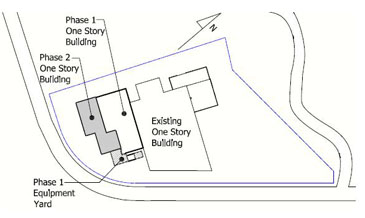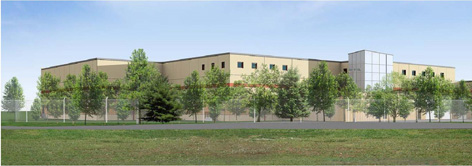| |
| Building Statistics - Part 1 |
| |
| General Building Data |
| |
|
| Building Name: |
Unknown Data Center Expansion |
| Location: |
Somewhere, USA |
| Occupancy/Type: |
Business - Data Center |
| Size: |
17,445 sf expansion to an additional 114,535 sf existing building |
| Number of Stories: |
1 |
| Dates of Construction: |
December 2008 – August 2010 |
| Cost: |
Building Cost - $27.5 Million
Overall Cost - $50 Million |
| Project Delivery Method: |
Design-bid-build |
| |
| Primary Project Team |
| |
|
|
| Owner: |
N/A |
|
| Construction Manager: |
Turner Construction Inc. |
WEBSITE |
| Architect: |
Sigma 7 Design Group |
WEBSITE |
| Mechanical/Electrical/Plumbing: |
Sigma 7 Design Group |
WEBSITE |
| Structural: |
Goldstein Associates |
WEBSITE |
| Civil: |
Birdsall Service Group |
WEBSITE |
| |
| Project Constraints |
| |
|
| Model Codes: |
IBC Building Code Edition 2006 |
| Zoning: |
Max Height – 55 Feet/75 feet (Sprinklers included)
Max Building Area – Unlimited
Min # of exits – 3 |
| Historical requirements: |
None |
| |
| Architecture |
| |
|
| Design and Function: |
The Data Center is one story expansion/renovation project consisting of roughly 17,500 square feet of a new addition to roughly an existing 114,500 square feet. This building is the second of three expansions. The project is designed for another a third expansion allowing for an additional 30,000 square feet. The addition will include more computer, electrical and mechanical rooms. As well as more storage and advanced data network distribution.

The building is a steel frame structure comprising of 40 feet by 25 feet columns bays. Due to heavy mechanical load and the slope of the roof, the structural engineer designed hollow structural tube (dunnage) to support the heavy mechanical equipment on the roof. These tubes are also used to support any mechanical rooms and/or penthouses located on the roof.
The data center is also designed for vibration isolation and seismic restraints for HVAC. All equipment, piping, ductwork and conduit must be seismically braced. |
| |
| Building Enclosure |
| |
|
| Building Facade: |
The Data Center’s shell is primarily made up of architectural precast concrete and is designed to withstand wind up to 200 miles per hour. A liquid membrane is used between the precast and flashing for maximum water protection. The precast is erected to bearing surfaces that must bear 2 ½ inches on steel and/or 3 inches on concrete block or masonry brick. Shims or jacks are used to align and level the precast panel.
The mechanical rooms and penthouse is enclosed with EIFS with 3 inch insulation with intake louvers on some areas of the rooms. The rooms are also equipped with acoustical silencer and dampers on a stand to account for any undesirable sound. |
| |
|
| Roofing: |
As stated above. The roof is equipped with hollow structural tubing to support any mechanical systems as well as penthouses. There are two types of these supporting tubes. One is an HSS 6X6 and the other a 4x4. There are hundreds of these supports located on the roof.
The roof is primarily constructed with EPMD fully adhered to concrete slab on deck. On top of the EPMD is interlocking insulation board covered with UV protection fabric and is topped off with interlocking concrete pavers. |
| |
| Sustainability Features |
| N/A |
| |

